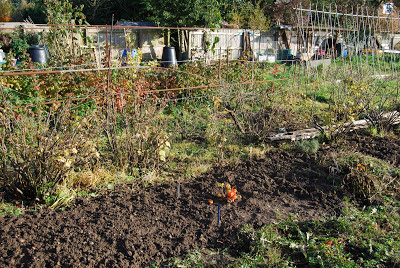The small holes in these potatoes are caused by wireworm, the larvae of the click beetle apparently, and it has affected nearly all my late spuds. They are supposedly most prevalent in areas which have recently been cleared of grass, but that is not true in this case. An alternative suggestion I have read is that they are more numerous where you have had manure, and that is certainly the case, I spread out the manure I inherited over my potato patch. The only cure is to wait for the end of the 4-5 year life cycle, which is fine because it will be 4-5 years before I put potatoes there again. I have never had a problem with wireworm before, and this year I have also had slug damage on my spuds for the first time.
This is almost my entire onion crop - pitiful isn't it! I grew them from seed, which I had not done before, and probably won't do again, except as an addition to sets.
Summer got off to a very late start, and also seemed to come to a very early end, and the peppers and chillies in the greenhouse are only just beginning to ripen, the chillies in the lead as you can see.
It was touch and go whether my second crop of sweetcorn would ever ripen, but it's just about there now. I am having to eat it all up as quickly as possible, before the frosts come. It's the best crop of sweetcorn I've had for many a year, so I would have been gutted if it had all gone to waste.
One great success was beans - climbing french and runner beans, as well as broad beans. In fact they did so well that nearly all of my dwarf beans went to waste, as I didn't have time to pick them, there were so many climbing ones (which are easier to pick after all). I won't bother with dwarf ones next year.
The most disappointing failures of the year have been the celery and celeriac, which bolted before they even got off the ground. Beetroot have been disappointing too. Many carrots failed to germinate, and many that did have split, presumably due to weather conditions. They are now being attacked by slugs where their shoulders emerge above the soil.
It hasn't been a good year for squashes, although I do have a few butternuts now, I'm not sure whether they will ripen, or whether I should take them in now before the frost, which I think there may be this weekend.
Despite the wet weather, the outdoor tomatoes didn't do too badly, but I have brought the remaining ones home to ripen. There was some blight, but I was able to keep it under control until recently, and I finally pulled all the remaining plants out today. The Ferline toms are definitely quite resistant.
It has been lovely to have so much fruit - I have made lots of jam, and we are still getting plenty of autumn raspberries. It takes ages to pick them all though.
As I have mentioned already I think, I will be dedicating a bit more space to cutting flowers next year, I have really enjoyed having a few in the house and I want to experiment with different kinds. It's a nice thing to take to people when you visit I think (especially when you can tell they're getting fed up with runner beans...)
I will also be cutting back on certain things (ie potatoes and beans!) and leaving a bit more space in between for harvesting. More sturdy supports for beans will also be required. And I probably won't bother with chard again, as it has just sat there, we haven't really eaten any. The leaves are all holey and ragged, they just don't look very appetising.
What will
you be doing differently next year?
















































